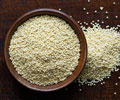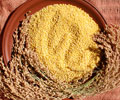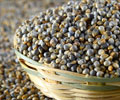- Millets are diverse types of grains that are produced across the world
- They are recognized to be highly packed with nutritional content like proteins, minerals – calcium, iron, potassium, magnesium, zinc, and vitamins
- It is found that consumption of different millets cuts down the risk of developing cardiovascular diseases
- They help in lowering total cholesterol, triglycerides, BMI, and even blood pressure
Read More..
Prevalence of Health Burden
One of the major contributors to the soaring rate of cardiovascular diseases and diabetes is an unhealthy diet. Apart from this, Obesity and being overweight are equally a donor to both wealthy and poorer countries. The burden of health ailments calls for solutions based on healthier diets.To overcome these challenges the present study was set to dig up the health benefits of different types of millets along with their cooking and processing styles. This may aid in supporting the need for more investments in grains and agribusiness developments.
What are Millets?
Millets are different variety of cereals /grains that are grown across the world. They can be of different colors – white, green, yellow, or red to different sizes – tiny to round in form. Millets are rich in nutritional content – almost three to five times better than rice and wheat. They are loaded with proteins, minerals like calcium, iron, potassium, magnesium, zinc, and vitamins.Above all, the good news is for those who have wheat allergies/intolerance is that they are gluten-free – an ideal match to overcome gastrointestinal (GI) discomfort.
Types of Millets
The different types of millets are:- Finger Millet (Ragi) – Reddish small grains that are a part of traditional Indian foods. A gluten-free variant of millet, and loaded with proteins, calcium, iron, and other minerals for brain growth and antioxidant activity.
- Foxtail Millet (Kakum/Kangni) – Commonly consumed as cooked grains, semolina, or rice flour. Rich in carbohydrates and iron content. Helps in regulating blood sugar levels in the body and improves overall immunity.
- Sorghum Millet (Jowar) – Popular Indian grain used to make rotis and other bread. They are the source of iron, protein, and fiber that boosts metabolism. The presence of policosanols helps in lowering cholesterol levels.
- Pearl Millet (Bajra) – Common types of millets, prepared in various ways like roti and khichdi. They are a perfect choice for the overall well-being of an individual and also battle against type II diabetes.
- Buckwheat Millet (Kuttu) – Used mostly during the festival (Navratra) fasting. Cuts down weight, diabetes, blood pressure, cardiovascular diseases, and protects against cancer.
- Amaranth Millet (Rajgira/Ramdana/Chola) – Fights grey hair and hair loss and reduces cholesterol levels and risk of cardiovascular diseases.
- Little Millet (Moraiyo/Kutki/Shavan/Sama) – An healthier alternative to rice and extensively used in Southern states of India.
- Barnyard Millet (Sanwa) – Strengthens bone density and improves bowel movement.
- Broomcorn Millet (Chena) – Has a low glycemic index and is a good option for diabetics.
- Kodo Millet (Kodon Millet) – One of the easily digestible variants with higher amounts of lecithin amino acid and gluten-free. It strengthens the nervous system and also aids in relieving high blood pressure and cholesterol levels, especially in postmenopausal women.
Study Data
The research team investigated 19 studies with nearly 900 people to summarize the benefits of the super-grain – millets. The study was initiated by five other organizations under ICRISAT.The participants were given a total of 50 to 200 g of millets per day for a duration ranging from 21 days to four months.
The millets cut down the risk of developing cardiovascular diseases by reducing total cholesterol by 8%. A 10% reduction in low and very-low-density lipoprotein cholesterol (bad cholesterols) and triglycerides (triacylglycerol) levels in blood were also found.
These contributed to almost 7% decrease in BMI (from 28.5 (+/-2.4) to 26.7 (+/-1.8) kg/m2). Moreover, millets also helped decrease blood pressure with a 5% reduction in diastolic blood pressure(the bottom number in the BP reading).
Opt for Millets
The study shows that millets are extremely high in unsaturated fatty acids, almost 2 to 10 times higher levels than refined wheat. The grains were also found advantageous over the milled rice and even whole grain wheat.These profitable effects of millets thereby support their role in fighting the expanding prevalence of obesity and overweight in children, adolescents, and adults.
With mounting evidence of health-promoting benefits in millets, the team stresses the crucial demand for scientific backup to popularise and restore millets to diets.
Positive Impact of Millets
"We were very surprised how many studies on humans had already been undertaken on the impact of millets on elements that impact cardiovascular diseases, and this is the very first time anyone has collated all these studies and analysed their data to test the significance of the impact. We used a meta-analysis, and results came out very strongly to show significant positive impact on risk factors for cardiovascular disease," says Dr. S. Anitha, study's lead author, and senior nutritionist at the ICRISAT.The authors conclude by highlighting the necessity for gaining a more deep-rooted comprehension of the consequences of millets on hyperlipidemia (high levels of lipids in the blood) and cardiovascular diseases.
“This latest review further emphasises the potential of millets as a staple crop that has many health benefits. It also strengthens the evidence that eating millet can contribute to better cardiovascular health by reducing unhealthy cholesterol levels and increasing the levels of whole grains and unsaturated fats in the diet,” says Professor Ian Givens, a co-author of the study and Director at the University of Reading’s Institute of Food, Nutrition, and Health (IFNH) in the UK.
Reference:
- Millet - (https://en.wikipedia.org/wiki/Millet)
Source-Medindia












